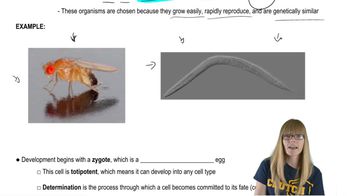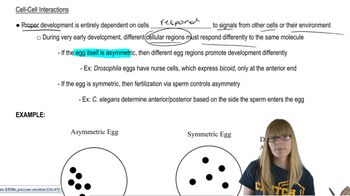What is the difference between a parasegment and a segment in Drosophila development? Why do developmental biologists think of parasegments as the subdivisions that are produced during the development of flies?
Table of contents
- 1. Introduction to Genetics51m
- 2. Mendel's Laws of Inheritance3h 37m
- 3. Extensions to Mendelian Inheritance2h 41m
- 4. Genetic Mapping and Linkage2h 28m
- 5. Genetics of Bacteria and Viruses1h 21m
- 6. Chromosomal Variation1h 48m
- 7. DNA and Chromosome Structure56m
- 8. DNA Replication1h 10m
- 9. Mitosis and Meiosis1h 34m
- 10. Transcription1h 0m
- 11. Translation58m
- 12. Gene Regulation in Prokaryotes1h 19m
- 13. Gene Regulation in Eukaryotes44m
- 14. Genetic Control of Development44m
- 15. Genomes and Genomics1h 50m
- 16. Transposable Elements47m
- 17. Mutation, Repair, and Recombination1h 6m
- 18. Molecular Genetic Tools19m
- 19. Cancer Genetics29m
- 20. Quantitative Genetics1h 26m
- 21. Population Genetics50m
- 22. Evolutionary Genetics29m
14. Genetic Control of Development
Early Developmental Steps
Problem 11
Textbook Question
In gain-of-function let-23 and let-60 C. elegans mutants, all of the vulval precursor cells differentiate with 1° or 2° fates. Do you expect adjacent cells to differentiate with 1° fates or with 2° fates? Explain.
 Verified step by step guidance
Verified step by step guidance1
Understand the context: In *C. elegans*, the vulval precursor cells (VPCs) adopt specific fates (1°, 2°, or 3°) during development. The let-23 and let-60 genes are part of the epidermal growth factor receptor (EGFR)/Ras signaling pathway, which regulates these cell fates.
Recognize the mutation type: Gain-of-function mutations in let-23 and let-60 lead to hyperactivation of the EGFR/Ras signaling pathway. This causes all VPCs to adopt either 1° or 2° fates, bypassing the default 3° fate.
Recall the normal signaling pattern: In wild-type *C. elegans*, the VPC closest to the anchor cell receives the strongest EGFR signal and adopts the 1° fate. Adjacent cells receive weaker lateral signals and adopt the 2° fate. Cells farther away adopt the default 3° fate due to lack of signaling.
Predict the outcome in mutants: In gain-of-function let-23 and let-60 mutants, the signaling pathway is constitutively active. This means that all VPCs are exposed to high levels of signaling, disrupting the normal gradient. Adjacent cells are unlikely to both adopt 1° fates because lateral inhibition (mediated by Notch signaling) prevents neighboring cells from adopting the same fate. Instead, adjacent cells will likely differentiate with alternating 1° and 2° fates.
Conclude the reasoning: The hyperactivation of the EGFR/Ras pathway ensures that all VPCs adopt induced fates (1° or 2°), but lateral inhibition ensures that adjacent cells do not both adopt 1° fates. Therefore, adjacent cells are expected to differentiate with alternating 1° and 2° fates.
 Verified video answer for a similar problem:
Verified video answer for a similar problem:This video solution was recommended by our tutors as helpful for the problem above
Video duration:
2mPlay a video:
Was this helpful?
Key Concepts
Here are the essential concepts you must grasp in order to answer the question correctly.
Vulval Development in C. elegans
In C. elegans, vulval development is a well-studied process involving a specific pattern of cell differentiation. The vulval precursor cells (VPCs) can adopt different fates, primarily 1° (primary) and 2° (secondary) fates, which are crucial for proper vulval formation. The fate of these cells is influenced by signaling pathways, particularly those involving the let-23 and let-60 genes.
Recommended video:
Guided course

Genetics of Development
Gain-of-Function Mutations
Gain-of-function mutations result in a gene product that has increased activity or a new function. In the context of let-23 and let-60 mutations in C. elegans, these mutations lead to enhanced signaling that promotes the differentiation of VPCs into 1° or 2° fates. Understanding how these mutations affect cell fate decisions is essential for predicting the behavior of adjacent cells.
Recommended video:
Guided course

Functional Genomics
Cell Communication and Fate Specification
Cell communication plays a critical role in determining the fate of adjacent cells during development. In C. elegans, the differentiation of VPCs is influenced by both intrinsic factors (like genetic mutations) and extrinsic signals from neighboring cells. This intercellular communication can lead to a coordinated response, where adjacent cells may adopt similar fates based on the signaling environment created by the differentiated VPCs.
Recommended video:
Guided course

Cell-cell interactions

 3:46m
3:46mWatch next
Master Drosophilia Development with a bite sized video explanation from Kylia
Start learningRelated Videos
Related Practice
Textbook Question
1205
views
